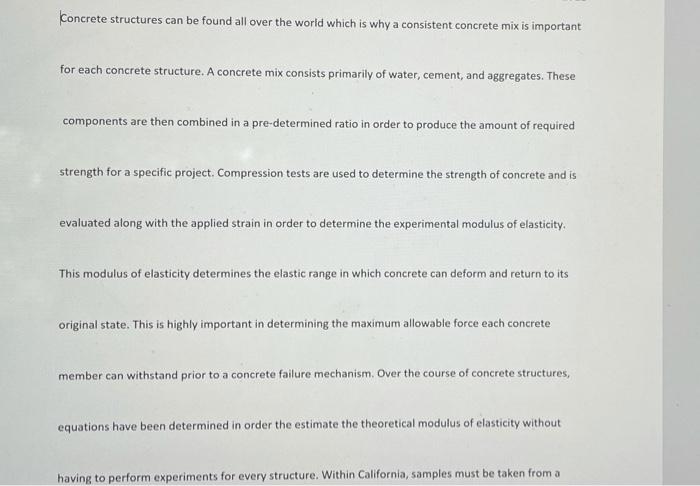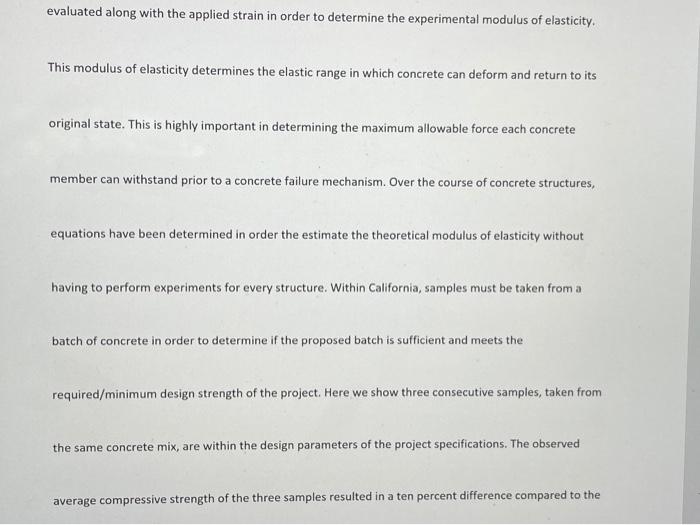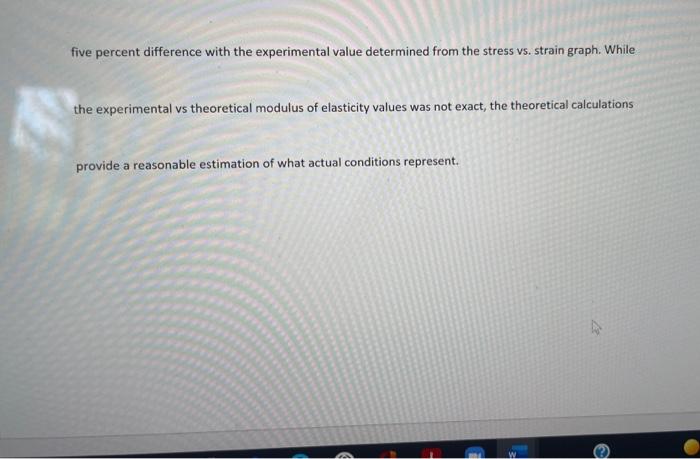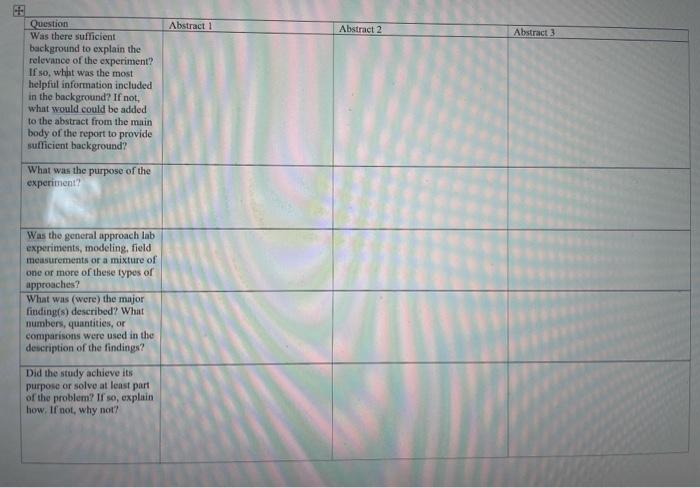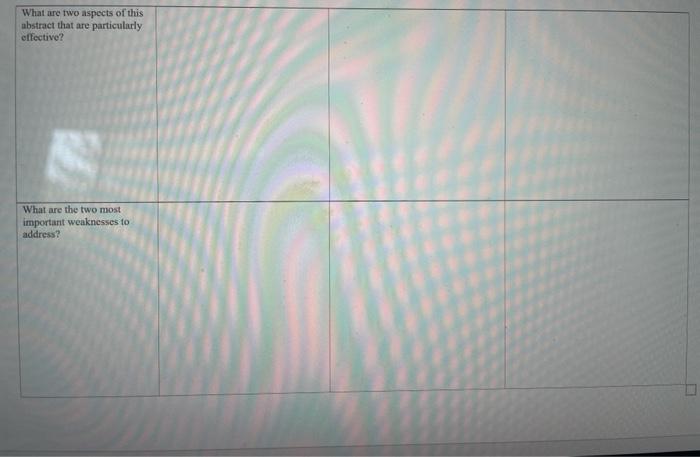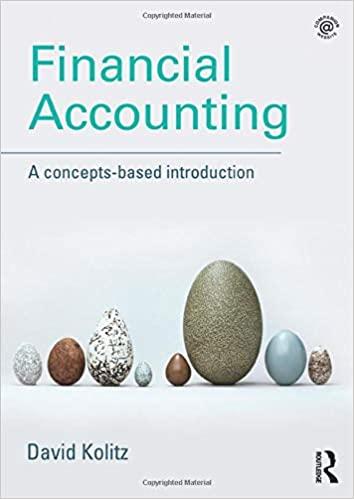Concrete structures can be found all over the world which is why a consistent concrete mix is important for each concrete structure. A concrete mix consists primarily of water, cement, and aggregates. These components are then combined in a pre-determined ratio in order to produce the amount of required strength for a specific project. Compression tests are used to determine the strength of concrete and is evaluated along with the applied strain in order to determine the experimental modulus of elasticity, This modulus of elasticity determines the elastic range in which concrete can deform and return to its original state. This is highly important in determining the maximum allowable force each concrete member can withstand prior to a concrete failure mechanism. Over the course of concrete structures, equations have been determined in order the estimate the theoretical modulus of elasticity without having to perform experiments for every structure. Within California, samples must be taken from a evaluated along with the applied strain in order to determine the experimental modulus of elasticity. This modulus of elasticity determines the elastic range in which concrete can deform and return to its original state. This is highly important in determining the maximum allowable force each concrete member can withstand prior to a concrete failure mechanism. Over the course of concrete structures, equations have been determined in order the estimate the theoretical modulus of elasticity without having to perform experiments for every structure. Within California, samples must be taken from a batch of concrete in order to determine if the proposed batch is sufficient and meets the required/minimum design strength of the project. Here we show three consecutive samples, taken from the same concrete mix, are within the design parameters of the project specifications. The observed average compressive strength of the three samples resulted in a ten percent difference compared to the five percent difference with the experimental value determined from the stress vs. strain graph. While the experimental vs theoretical modulus of elasticity values was not exact, the theoretical calculations provide a reasonable estimation of what actual conditions represent. Abstract 1 Abstract 2 Abstract Question Was there sufficient background to explain the relevance of the experiment? If so, what was the most helpful information included in the background? If not, what would could be added to the abstract from the main body of the report to provide sufficient background? What was the purpose of the experiment? Was the general approach lab experiments, modeling, field measurements or a mixture of one or more of these types of approaches? What was (were the major finding(s) described? What numbers, quantities, or comparisons were used in the description of the findings? Did the study achieve its purpose or solve at least part of the problem? If so, explain how. If not, why not? What are two aspects of this abstract that are particularly effective? What are the two most important weaknesses to address? Concrete structures can be found all over the world which is why a consistent concrete mix is important for each concrete structure. A concrete mix consists primarily of water, cement, and aggregates. These components are then combined in a pre-determined ratio in order to produce the amount of required strength for a specific project. Compression tests are used to determine the strength of concrete and is evaluated along with the applied strain in order to determine the experimental modulus of elasticity, This modulus of elasticity determines the elastic range in which concrete can deform and return to its original state. This is highly important in determining the maximum allowable force each concrete member can withstand prior to a concrete failure mechanism. Over the course of concrete structures, equations have been determined in order the estimate the theoretical modulus of elasticity without having to perform experiments for every structure. Within California, samples must be taken from a evaluated along with the applied strain in order to determine the experimental modulus of elasticity. This modulus of elasticity determines the elastic range in which concrete can deform and return to its original state. This is highly important in determining the maximum allowable force each concrete member can withstand prior to a concrete failure mechanism. Over the course of concrete structures, equations have been determined in order the estimate the theoretical modulus of elasticity without having to perform experiments for every structure. Within California, samples must be taken from a batch of concrete in order to determine if the proposed batch is sufficient and meets the required/minimum design strength of the project. Here we show three consecutive samples, taken from the same concrete mix, are within the design parameters of the project specifications. The observed average compressive strength of the three samples resulted in a ten percent difference compared to the five percent difference with the experimental value determined from the stress vs. strain graph. While the experimental vs theoretical modulus of elasticity values was not exact, the theoretical calculations provide a reasonable estimation of what actual conditions represent. Abstract 1 Abstract 2 Abstract Question Was there sufficient background to explain the relevance of the experiment? If so, what was the most helpful information included in the background? If not, what would could be added to the abstract from the main body of the report to provide sufficient background? What was the purpose of the experiment? Was the general approach lab experiments, modeling, field measurements or a mixture of one or more of these types of approaches? What was (were the major finding(s) described? What numbers, quantities, or comparisons were used in the description of the findings? Did the study achieve its purpose or solve at least part of the problem? If so, explain how. If not, why not? What are two aspects of this abstract that are particularly effective? What are the two most important weaknesses to address
